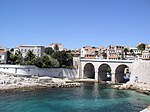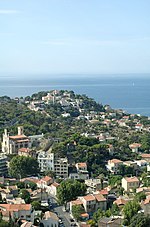General levelling of France
Geography of FranceTopography
The General Levelling of France (niveau général de la France or NGF) forms a network of benchmarks in mainland France and Corsica, now overseen by the Institut Géographique National. It is now the official levelling network in mainland France. It is made up of two networks: NGF - IGN69 for mainland France, with the 'zero level' determined by the tide gauge at Marseille NGF - IGN78 for Corsica, with the 'zero level' determined by the tide gauge at Ajaccio
Excerpt from the Wikipedia article General levelling of France (License: CC BY-SA 3.0, Authors).General levelling of France
Corniche du Président John Fitzgerald Kennedy, Marseille 7th Arrondissement
Geographical coordinates (GPS) Address Nearby Places Show on map
Geographical coordinates (GPS)
| Latitude | Longitude |
|---|---|
| N 43.278333333333 ° | E 5.3533333333333 ° |
Address
Marégraphe
Corniche du Président John Fitzgerald Kennedy
13007 Marseille, 7th Arrondissement
Provence-Alpes-Côte d'Azur, France
Open on Google Maps









